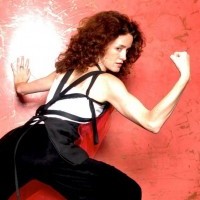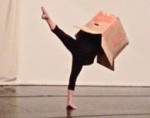
Words on Martha's Museum
by tD Writers
On the occasion of Elizabeth Zimmer’s third writing workshop with our cohort, twenty thINKingDANCE writers attended, en masse, the Martha Graham Dance Company’s performance at the Annenberg Center. The opportunity for simultaneous viewing, writing, and work-shopping provided a vigorous response, some of which we’ve excerpted here (excising some good writing on the too-new-to-review preview, Deo, at the request of the company). Struggle is sewn through these responses to the nonagenarian Martha Graham Dance Company; these snapshots and sketches illuminating her status in a manner perhaps akin to Hokusai’s views of Mt. Fuji— each forever looming as the world around them changes. (Anna Drozdowski)
Eve’s Rib (by Mira Treatman)
The biblical figure Eve does not suffice as a curatorial impetus in 2019.
Number one: Dancing women have been compared to a naked sinner enough already.
Number two: Is there any trope more obvious?
Number three: Judeo-Christianity.
Yet, here at The Annenberg Center, Eve reigns as the uniting force in The Martha Graham Dance Company’s national tour, “The EVE Project.” Connecting Eve to women’s suffrage worsens the deal. Artistic Director Janet Eilber delivers a competent but troubling curtain speech explaining why Eve is invited to the table. From 2018-2020 the company is presenting works that commemorate the centennial of (white) women’s suffrage. In a statement from Eilber reported in the New York Times, “The EVE Project connects audiences—in the ephemeral and visceral way dance does—to both historical and contemporary ideas of the feminine.” The project includes Graham works that celebrate the aforementioned feminine in addition to commissioning work by women choreographers.
Gender nonconformity does not exist in this robustly funded project. To meaningfully catalyze audiences in 2019 cultural leaders must advocate for the normalization of soft, feminine men, for badass door-busting women, for people who contain the multitudes of both and neither. “Feminine” does not equate to “woman.”
Despite my labored viewing, I accept that these women perform the results of thousands of studio hours over their lifetimes. I accept the blessing of witnessing them for 90 minutes with no intrusions. I accept that no single dance can solve all of my problems. I am softening to the virtuosity. In the end, the company truly does inspire melodramatic poetry in me. I resist it, but as the curtain falls I feel millions of cast-off ribs stabbing me in the trunk, maybe a couple in the ovaries for good measure. Martha Graham laughs somewhere in Hades. I resolve to keep making space for Eve to exist in the world as she pleases, feminine and otherwise.
Of Line and Lineage (by Jenna Horton)
(excerpted) According to the program, The EVE Project “celebrates women and the 100th Anniversary of the 19th Amendment.” I’m here to celebrate women all day every day, but let’s drag that assumption lurking behind the anniversary mention of the 19th Amendment—that all women gained the right to vote. Since 1920, black women, Native American women, Asian American women, and some poor white women have been denied the vote in a variety of forms across a variety of states. Not what I’m here to talk about, but talking about it nonetheless.
Martha Graham #WomensEmpowerment (by Jonathan Stein)
How does a 92-year old modern dance company maintain a current dance groove? And especially a company carrying the name and weighty legacy of the iconic Martha Graham, who, for many, gave modern dance its face and body?
The Martha Graham Dance Company has chosen to present reconstructions of the Graham repertory joined by newly commissioned work and allied by a thematic tie. The EVE Project theme, for the company’s return to the Annenberg Center, is the coming 100th anniversary of the 19th Amendment giving women the right to vote. In 1919 Graham was a 25-year old with the seminal Denishawn School of Ruth St. Denis and Ted Shawn. This strategy offers audiences multiple ways to test the vitality of the Graham legacy and designated theme.
Diversion of Angels (1948), highlights the stylized excesses of Graham’s well-honed theatricality and perhaps contravenes the theme of female empowerment through its idealized and stereotyped representation of female sensuality. The dance presents three couples, with women in white, red, and yellow, each in turn, according to a program note, representing “mature love in perfect balance, erotic love and adolescent love.” Our woman in white holds stoical, static poses; the woman in red wriggles languorous arms; and the woman in yellow bounces buoyantly across the floor. The woman in white is the sole survivor. No contest. Not much empowerment.
The riveting solo Ekstasis (1933) comes from the first decade of the Graham company, when it was an all-women group, and is “reimagined” by Virginie Mécène from photographs by Soichi Sunami and Barbara Morgan. Anne Souder, bathed in an overhead light amidst a dark surround, extends her pelvis and hips in slow then activated motion and gradually engages her torso in contrapposto spirals. Her clinging, floor-length dress highlights the components of what was to become Graham’s signature contraction and release technique. Souder’s methodical minimalist execution creates a captivating mystery without theatrics.
Chronicle (1936) is a classic ode to women’s empowerment in the face of oppression and at a time of war, created when Graham had refused an invitation from Nazi Germany to take part in the 1936 Olympic Games. To military drum rolls, Xin Ying flashes and spins a voluminous gown from its black to its red side, telegraphing impending danger and catastrophe. The ensemble extend their arms in the iconic Graham style, but their meaning is now political. Their gallops across the stage portend chaos afoot; a unison line of women suggests warriors across a Greek vase.
Power to spare.
Contemporary Anthropology (by Carolyn Merritt)
A moving statue aglow under a spotlight, Anne Souder juts her limbs and oozes curves, every last inch of her frame neatly stuffed into a snug ivory tank dress, as if she were poured into a casting mold. She bends sideways, her torso extending fully parallel to the floor, her right hip counterbalancing at a distance that registers as an ache in my own. Wind chimes, some variety of flute, and marimba-like percussion lend this version of Ekstasis—reimagined largely from photos of Graham’s 1933 solo and set to new music by Ramon Humet—an ethnographic air. Graham’s Denishawn heritage, and the exoticizing Orientalism that the music implies, hangs heavy on this recreation. A hieroglyph in motion, Souder carves a path with her elbows, the effect, in concert with the music, equal parts travelogue and appropriation. Yet these sharp angles dissolve into lush, rippling undulations that seem downright contemporary. In her pre-performance notes, Artistic Director Janet Eilber cites Graham’s discovery of a new relationship between hip and shoulder as the seed of the piece. Like an explorer drunk on the thrill of discovery, Souder delights in the landscape of her own body, the dance at once a celebration and a conquest.
Questions of imperialism plague the arts to this day, even among creators who claim the best of intentions and the most solid of credentials (see Hamilton’s complicated journey to Puerto Rico). Watching Ekstasis, I cannot ignore its colonialist origins. It is right to question the restaging of dated works, to interrogate their value systems (explicit and implicit), to ask when and how they might be manipulated for contemporary audiences, or, indeed, whether they best remain left behind. And yet I thrill at witnessing Graham’s iconic repertory live. To paraphrase Susan Sontag, we cannot understand if we do not remember. I don’t know that the company’s restaging is (or even wants to be) “postcolonial,” but Souder’s performance compels us to consider the body’s power—to speak back, to shake off the dust of a century, to reconstruct from the ashes an archive that answers the question of its survival.
On the Eve of Fourth-Wave Feminism (by Kat Sullivan)
I accept that Graham's works may not stand the Bechdel Test of time when under the contemporary feminist lens, and perhaps in their historical context they may have been considered more groundbreaking. Yet, I still take issue with this modern staging. Although Diversion of Angels begins and ends with Ben Schultz holding his hand behind Natasha M. Diamond-Walker's head, as if coronating a regal woman with a crown, it is ultimately still the man's hand.
The EVE Project, Martha Graham Dance Company, Annenberg Center for the Performing Arts, January 25-26.
By Jonathan Stein
February 24, 2019
























